
Mussel is the common name used for members of several families of bivalve molluscs, from saltwater and freshwater habitats. These groups have in common a shell whose outline is elongated and asymmetrical compared with other edible clams, which are often more or less rounded or oval.

The northern riffleshell is a subspecies of freshwater mussel, an aquatic bivalve mollusk in the family Unionidae, the river mussels. This mussel is endangered and federally protected. It was proposed as a species, Epioblasma rangiana, by Williams et al. (2017).

The Unionidae are a family of freshwater mussels, the largest in the order Unionida, the bivalve molluscs sometimes known as river mussels, or simply as unionids.

Unionida is a monophyletic order of freshwater mussels, aquatic bivalve molluscs. The order includes most of the larger freshwater mussels, including the freshwater pearl mussels. The most common families are the Unionidae and the Margaritiferidae. All have in common a larval stage that is temporarily parasitic on fish, nacreous shells, high in organic matter, that may crack upon drying out, and siphons too short to permit the animal to live deeply buried in sediment.
Anodontoides radiatus is a species of freshwater mussel, an aquatic bivalve mollusk in the family Unionidae, the river mussels. In 2018, Smith, Johnson, Pfeiffer and Gangloff placed this species in genus Strophitus on the basis of morphological and molecular features. As of 2023, it is under review for listing under the Endangered Species Act of 1973.

Anodontoides is a genus of freshwater mussels, an aquatic bivalve mollusk in the family Unionidae, the river mussels.

Epioblasma flexuosa, the arcuate pearly mussel or leafshell, was a species of freshwater mussel, an aquatic bivalve mollusk in the family Unionidae, the river mussels. This species was endemic to the United States, where it was found in the major drainages of the Ohio River, including the Cumberland, Tennessee, and Wabash Rivers. Its natural habitat was flowing water.
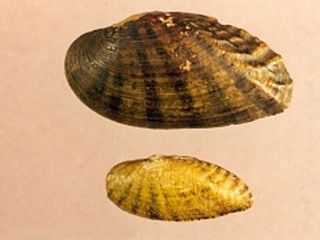
Medionidus acutissimus, the Alabama moccasinshell, is a species of freshwater mussel in the family Unionidae, the river mussels. It is native to Alabama, Mississippi, Georgia, Tennessee, and possibly Florida. It is a federally listed threatened species of the United States.

Medionidus penicillatus, the gulf moccasinshell, is a rare species of freshwater mussel in the family Unionidae, the river mussels. This aquatic bivalve mollusk is native to Alabama, Florida, and Georgia in the United States, where it is in decline and has been extirpated from most of the rivers it once inhabited. It is a federally listed endangered species of the United States.
The round ebonyshell is a species of freshwater mussel, an aquatic bivalve mollusk.
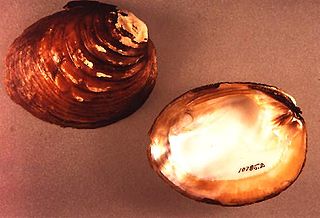
Plethobasus cicatricosus, the white warty-back pearly mussel or white wartyback, is a species of freshwater mussel in the family Unionidae, the river mussels. Once widely distributed in the Ohio, Cumberland, and Tennessee River systems in the United States, its range has declined dramatically to the point of near-extinction. It is a federally listed endangered species of the United States.

Theliderma intermedia, the Cumberland monkeyface pearly mussel or Cumberland monkeyface, is a species of freshwater mussel in the family Unionidae, the river mussels. This aquatic bivalve mollusk is native to Tennessee and Virginia in the United States. Historically widespread in the upper Tennessee River system, it populations have been reduced by habitat destruction and pollution. It now only occurs in two tributaries: the Duck and Powell Rivers. It is a federally listed endangered species.

Theliderma sparsa, the Appalachian monkey-face pearly mussel or Appalachian monkeyface, is a species of freshwater mussel, an aquatic bivalve mollusk in the family Unionidae, the river mussels.
Freshwater bivalves are molluscs of the order Bivalvia that inhabit freshwater ecosystems. They are one of the two main groups of freshwater molluscs, along with freshwater snails.
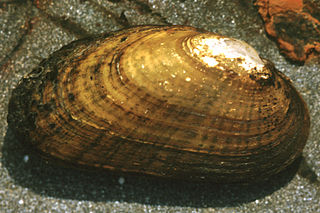
Villosa iris, the rainbow mussel or rainbow-shell, is a species of freshwater mussel, an aquatic bivalve mollusk in the family Unionidae, the river mussels. In 2018, Watters proposed to move the species into a new genus, Cambarunio.

The shinyrayed pocketbook is an endangered species of freshwater mussel in the family Unionidae, the river mussels. This species is endemic to the United States in the states of Georgia, Florida, and Alabama.
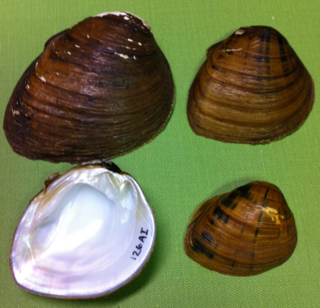
Pleuronaia dolabelloides, the slab-sided naiad, slab-sided pearly mussel, or slabside pearlymussel, is a species of freshwater mussel, an aquatic bivalve mollusk in the family Unionidae, the river mussels. This species was formerly classified under the genus Lexingtonia.

Potamilus fragilis, previously Leptodea fragilis, the fragile papershell, is a species of freshwater mussel, an aquatic bivalve mollusk in the family Unionidae, the river mussels. P. fragilis is one of the fastest-growing unionid species and the most abundant unionid species in Lake Erie. Its light-shelled morphology suggests an adaptation to deep water within lakes.
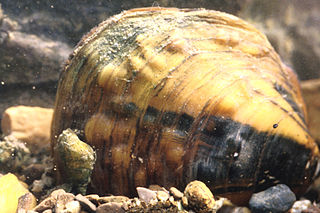
Cyclonaias pustulosa, the pimpleback, is a species of freshwater mussel, an aquatic bivalve mollusk in the family Unionidae, the river mussels. This species is native to North America, where it is widespread and common. It has possibly been extirpated from New York, however, and populations in Pennsylvania are critically imperiled, according to NatureServe.

Ambleminae is a subfamily of freshwater mussel in the family Unionidae. They are found throughout much of eastern North America south to Central America, although fossils are also known from Siberia. Some species have also been introduced to East Asia. They are the most speciose radiation of the Unionidae, with more than 300 species.

















